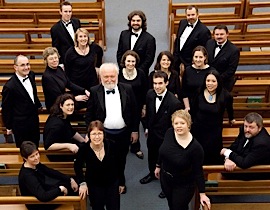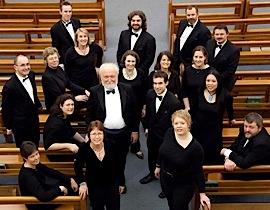
O’Donnell cultivates a warm sound from his singers, refined and a little thin, with some dark hues especially in the women’s voices. It’s finely blended within the sections and generally well balanced, though a stronger alto presence would be welcome at times. At its best the group conveys a highly appealing purity of sound, but other times the effect is of immobility, a feature abetted by O’Donnell’s rigid conducting style.
The evening’s repertory choices fell mostly along two strands: Renaissance sacred polyphony and modern choral works. The differences in approach were often palpable, as evidenced by two pieces of different eras but bearing the same title. The Christmas motet O magnum mysterium (O great mystery) of Jacob Clemens non Papa was elegant, careful, and regular to the point of being foursquare. Repeated iterations of the text “Noe” revealed Ensemble Gombert’s capacity for detailed nuance and left you wanting for more of such gestures. Morten Lauridsen’s O magnum mysterium, in contrast, carried a dramatic arc from solemn opening phrases to a dramatic, thrilling close, marred only by some imprecise attacks along the way.
In Josquin Desprez’ Inviolata, integra, et casta es Maria (Inviolate, pure, and chaste art thou, O Mary) the group’s dark-tinged sound suitably matched the beseeching nature of the text, though a firmer sense of forward motion might have enlivened the plangent closing pleas “O benigna! O Regina! O Maria!” (O generous one! O Queen! O Mary!). A similar pallor lies over Jean Mouton’s Quis dabit oculis nostris (Who will give our eyes [a fountain of tears]), a lament upon the death of Queen Anne of Brittany. Here the ensemble displayed more-pleasing contrasts, from the pristine opening lines to graceful texture alternations between the upper and lower voices.
With the joyful message of Nicolas Gombert’s Hodie nobis caelorum Rex (This day hath the King of heaven [deigned to be born]) the ensemble gathered energy, proclaiming the words with greater vigor and confidently handling the shifting metrical figurations that close each of the work’s two sections. In Thomas Tallis’ responsory Loquebantur variis linguis ([The apostles] were speaking in different tongues), more could have been made of the contrast between the tenor’s fixed declamation of chant and the meandering polyphony surrounding it.
Elliott Carter’s Musicians wrestle everywhere, set to a poem by Emily Dickinson, is a higgledy-piggledy mixture of contrapuntal melodies, texture shifts, and stark declamations. The group ably negotiated the piece’s rapid-fire shifts and dissonant harmonies. Works by two of Ensemble Gombert’s own tenors further enlivened the program. Vaughan McAlley’s In principio erat verbum (In the beginning was the Word), composed in a Renaissance idiom, infused excitement through contrasting sections of counterpoint, solemn homophony, and a sprightly closing declaration of glory. Peter Campbell’s Sunrise on the Coast conveyed a more impressionist feel, the opening bursts of blowing wind yielding to a panoply of shifting styles and moods, with an interior fugue for good measure.
As a closer, J.S. Bach’s masterful funeral motet Jesu, meine Freude affords opportunities for all manner of expression: lively choruses, contemplative trios, stately chorales, and a brisk central double fugue. The ensemble easily handled each movement’s technical challenges and displayed a pleasing range of moods from quiet introspection to vigorous exhortation, which could have been further enhanced through greater dynamic and rhythmic energy.

